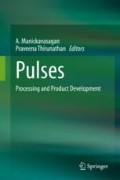Abstract
The hyacinth bean (include the scientific name here) is a tropical and subtropical food legume which is of Asian origin. In Europe, Africa, Middle East, America, and Asia, hyacinth beans have been cultivated for many years. Leaves, green beans, and pods of hyacinth beans are edible and consumed widely (Maass et al. 2010). Lablab purpureus are climbing plants that can grow up to a length of 5 m, with leaves 3-foliate and pinnate, 6–12 cm by 5–9 cm acute leaflets, purplish pink or white flowers, and green podded fruits with 4–5 seeds, flattened 6 cm long and 2 cm wide. Color change of pods from green to light brown is used as a maturity index (Al-Snafi 2017). Different names of hyacinth beans are hyacinthbean, Egyptian bean, field bean, bonavist bean, and Dolichos lablab L., Lablab niger Medikus, Lablab vulgaris (L.) Savi, Lablab purpureus (L.) Sweet, Vigna aristata Piper, Dolichos benghalensis Jacq., and Dolichos purpureus L., are the different scientific names (Sheahan 2012).
Access this chapter
Tax calculation will be finalised at checkout
Purchases are for personal use only
References
Acevedo, B. A., Avanza, M. V., Cháves, M. G., & Ronda, F. (2013). Gelation, thermal and pasting properties of pigeon pea (Cajanus cajan L.), dolichos bean (Dolichos lablab L.) and jack bean (Canavalia ensiformis) flours. Journal of Food Engineering, 119(1), 65–71.
Akpapunam, M. (1996). Hyacinth bean (Lablab purpureus (L.) sweet). In Food and feed from legumes and oilseeds (pp. 103–108). Boston: Springer.
Al-Snafi, A. E. (2017). The pharmacology and medical importance of Dolichos lablab (Lablab purpureus)-A review. IOSR Journal of Pharmacy, 7(2), 22–30.
Boyette, M. D., Schulteis, J. R., Estes, E. A., Hurst, W. C., & Sumner, P. E. (1994). Postharvest cooling and handling of green beans and field peas. AG (North Carolina Agricultural Extension Service)(USA).
D’souza, M. R. (2013). Effect of traditional processing methods on nutritional quality of field bean. Advances in Bioresearch, 4(3), 29.
Duke, J. A. (1983) Handbook of Legumes of World Economic Importance. Plenum Press, New York, pp 102–106, 275–278, 293–296.
Grizzell, W. G. (1961). Handling pea beans in country elevators (No. 479). US Department of Agriculture, Agricultural Marketing Service, Transportation and Facilities Research Division and Market Quality Research Division.
Habib, H. M., Theuri, S. W., Kheadr, E. E., & Mohamed, F. E. (2017). Functional, bioactive, biochemical, and physicochemical properties of the Dolichos lablab bean. Food & Function, 8(2), 872–880.
Kala, B. K., Soris, P. T., Mohan, V. R., & Vadivel, V. (2010). Nutrient and chemical evaluation of raw seeds of five varieties of Lablab purpureus (L.) sweet. Advances in Biology Research, 1(1), 44–53.
Kincade, K. P. (1985). The A-to-Z of dry bean handling. In Proc Technical Conference on Dry Beans Research.
Lei, N., Shu, G., Cao, J., Wan, H., & Feng, J. (2016). Extraction and antioxidant activities assay of polysaccharides from white hyacinth bean and promoting growth to probiotics. Annals of the University Dunarea de Jos of Galati Fascicle VI--Food Technology, 40(2), 51–62.
Maass, B. L., Knox, M. R., Venkatesha, S. C., Angessa, T. T., Ramme, S., & Pengelly, B. C. (2010). Lablab purpureus—A crop lost for Africa? Tropical Plant Biology, 3(3), 123–135.
Maheshu, V., Priyadarsini, D. T., & Sasikumar, J. M. (2013). Effects of processing conditions on the stability of polyphenolic contents and antioxidant capacity of Dolichos lablab L. Journal of Food Science and Technology, 50(4), 731–738.
Mosisa, M. T., & Tura, D. C. (2017). Effect of processing on proximate and mineral composition of hepho, a black climbing bean (Lablab purpureus L.) flour. Journal of Food and Nutrition Sciences, 5, 16–22.
Paredes-López, O., Maza-Calviño, E. C., & González-Castañeda, J. (1989). Effect of the hardening phenomenon on some physicochemical properties of common bean. Food Chemistry, 31(3), 225–236.
Pirhayati, M., Soltanizadeh, N., & Kadivar, M. (2011). Chemical and microstructural evaluation of ‘hard-to-cook’ phenomenon in legumes (pinto bean and small-type lentil). International Journal of Food Science & Technology, 46(9), 1884–1890.
Sheahan, C. M. (2012). Plant guide for Lablab (Lablab purpureus), USDA-Natural Resources Conservation Service, Cape May Plant Materials Center. Cape May, NJ, 8210.
Shilpaa, B., Akankshaa, K., & Girish, P. (2012). Evaluation of cactus and hyacinth bean peels as natural coagulants. International Journal of Chemical and Environmental Engineering, 3(3), 187.
Subagio, A. (2006). Characterization of hyacinth bean (Lablab purpureus (L.) sweet) seeds from Indonesia and their protein isolate. Food Chemistry, 95(1), 65–70.
Subagio, A., & Morita, N. (2008). Effects of protein isolate from hyacinth beans (Lablab purpureus (L.) sweet) seeds on cake characteristics. Food Science and Technology Research, 14(1), 12–17.
Thompson, J. A. (1962). Maintaining quality of pea beans during shipment overseas (No. 519). US Department of Agriculture, Agricultural Marketing Service, Market Quality Research Division.
Uebersax, M. A., Kim, J. N., & Chung, Y. S. (1996). Packaging and handling systems for dry edible beans. Michigan Dry Bean Digest, 20(2), 5–13.
Uebersax, M. A., & Siddiq, M. (2013). Postharvest storage quality, packaging and distribution of dry beans. In M. Siddiq & M. A. Uebersax (Eds.), Dry beans and pulses: Production, processing and nutrition (pp. 75–100). Ames: Wiley.
Valenzuela, H., & Smith, J. (2002). Sustainable agriculture green manure crops. SA-GM-7. Cooperative Extension Service, College of Tropical Agriculture and Human Resources, University of Hawaii at Manoa.
Author information
Authors and Affiliations
Corresponding author
Editor information
Editors and Affiliations
Rights and permissions
Copyright information
© 2020 Springer Nature Switzerland AG
About this chapter
Cite this chapter
Athmaselvi, K.A., Sukumar, A., Bhokarikar, S. (2020). Hyacinth Beans. In: Manickavasagan, A., Thirunathan, P. (eds) Pulses. Springer, Cham. https://doi.org/10.1007/978-3-030-41376-7_7
Download citation
DOI: https://doi.org/10.1007/978-3-030-41376-7_7
Published:
Publisher Name: Springer, Cham
Print ISBN: 978-3-030-41375-0
Online ISBN: 978-3-030-41376-7
eBook Packages: Biomedical and Life SciencesBiomedical and Life Sciences (R0)

